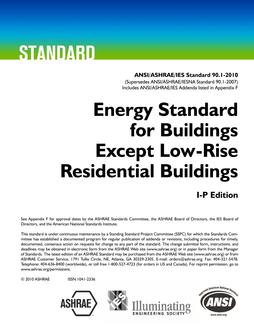

They are selected as space savers and are used in many applications where security, reliability, and durability are paramount. Fortunately, recent advances in rolling doors are significantly improving their energy efficiency. They work particularly well in low-headroom situations, as rolling doors are stored in a compact coil at the head of the opening. While sectional doors are more energy efficient than rolling doors, there are many situations where rolling products are the best-and sometimes only-option for a closure product. This is changing, as manufacturers are now able to powder coat custom images onto doors, either to help the door stand out or even blend into a larger design aesthetic. There are many benefits to selecting rolling exterior doors, but traditionally aesthetics were not at the top of that list.

#Ashrae 90.1 code
Enhancements to the aesthetics of rolling door products can support a wide range of design intentions, while also achieving mandatory code compliance. Advances in exterior rolling door construction enable new rolling doors to exceed current air infiltration codes by as much as 73 percent. The doors were powder coated with an orange that matches the brand’s color guidelines.Įxterior rolling door manufacturers are one of many industry leaders who have developed high-performance products to meet these new stringent performance goals. The rolling steel doors protect the venue and equipment when not in use. New durable rolling doors are meeting and exceeding energy codes, providing improved sound attenuation, and can be finished with attractive, no-VOC colors, as shown in the door for this new Harley Davidson distributor facility. Controlling air infiltration is an important strategy for design professionals focusing on the reduction of energy use and is a crucial part of achieving a building with net-zero energy usage. Air infiltration is defined as the unintended or accidental flow of air through a building envelope via cracks in the building envelope-particularly in and around door and window openings. Code authorities have recognized that reducing air infiltration is crucial when improving the energy performance of exterior rolling doors. In the near future, it is highly likely that a well-designed building will be expected to meet the goals of net-zero energy usage.Ī greater industry focus on improved energy performance standards has led to changes in regulations, codes, green building rating systems, and building products. They are designing to meet new high-performance criteria and using energy models to meet net-zero energy use.

Green Building Council’s LEED and Green Globes.Īccording to Desjarlais, ASHRAE is currently working on a revision to the 90.1-2007 standards - due to be released sometime next year - that boosts the existing levels by more than 30 percent.Design professionals are increasingly demanding products that meet and exceed code requirements. Just as energy costs are increasing over the long term, so too are the standards proposed by organizations such as ASHRAE, the U.S. The temporary dip in energy costs is just that there’s little doubt that energy prices will once again resume an upward march.įacility executives who consider going to levels above and beyond existing standards might want to increase their anticipated specifications. “ Wading through many options for energy design, construction materials, and equipment may be challenging but should quite literally pay off in the long run,” says Greg Crawford, executive director for the Cool Metal Roofing Association.Īlthough it might be tempting to put off needed efficiency improvements - especially given the economic downturn and lower energy costs - it is not a fruitful decision. It is much easier to achieve 90.1 levels when designing new facilities, as opposed to existing buildings, he says, which is a sentiment that is echoed by others in the building industry. “ One way of determining how out of date you are,” he says, “is to look at ASHRAE 90.1 - the 2007 revision.” The ideal solution, according to Desjarlais, is fairly simple: Retrofit to the existing standard. Most experts recommend that facility executives concerned about envelope efficiency should build beyond that standard.īut what about buildings constructed long before the advent of modern ASHRAE standards? With efficiency standards, there is also a significant difference between new construction and existing buildings.įor new construction, ASHRAE 90.1 is the baseline for efficiency - the bare minimum.


 0 kommentar(er)
0 kommentar(er)
